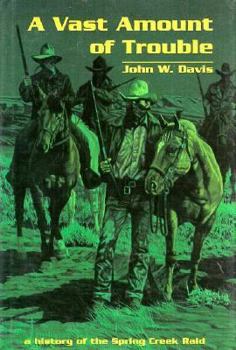A Vast Amount of Trouble: A History of the Spring Creek Raid
In late March 1909, five sheepmen headed east from the town of Worland, in north-central Wyoming, driving five thousand sheep. A few days later the men and their sheep camped on the banks of Spring... This description may be from another edition of this product.
Format:Hardcover
Language:English
ISBN:0870813102
ISBN13:9780870813108
Release Date:January 1993
Publisher:University Press of Colorado
Length:291 Pages
Weight:0.70 lbs.
Dimensions:0.9" x 6.3" x 9.3"
Customer Reviews
2 ratings
Highly recommended for rural law dawgs and attorneys
Published by Thriftbooks.com User , 17 years ago
As a former deputy sheriff in the nowood valley, Ten Sleep, Wyoming, I found Mr. Davis' research and presentation outstanding. His descriptions and evaluations were right on the money. As a critical history buff, I was pleasantly surprised to find no faults or criticisms of Mr. Davis' work. I thoroughly enjoyed this book and highly recommend it to anyone with an interest in historical jurisprudence. Things might have changed in "crime detection/investigation" but in the courtroom? not so much.
Burnedblack Mountain
Published by Thriftbooks.com User , 18 years ago
Wyoming looms large for me, and I've alluded to a recent film about Wyoming "cowboys" in other reviews. Attorney John Davis, from somewhere in the Big Horn Basin, discusses events of 2 April 1909 that put the cowboy canard in its place. Those movie cowboys aren't cowboys because they're all hat and no cattle. They're sheepherders. So were Joe Allemand, shot to death on 2 April 1909, and Joe Enge, murdered and burned in his sheep wagon on Spring Creek. Spring Creek was the last big battle of the western sheep wars, writes Mr. Davis, and was the first (only) Wyoming raid in which killers of sheepherders were convicted of murder. The murderers of Allemand, Emge, and another herder, burned to death with Emge in his wagon, were real cowboys acting out a drama that was a tragedy of the commons. Much of Wyoming even in 1909 was unfenced open range to which cattlemen claimed rights of preemption. Sheep and their crazy herders (cowboys debated overwhelming questions: Were men already crazy before they herded sheep, or were they made crazy by the sheep they herded?) were latecomers who competed for grass and water in a dry state. Sheep wrecked the range for cattle, eating grass down to the ground and then eating the ground. Then they'd bleat and excrete, wrecking water holes. In the Big Horn Basin commons, cattlemen and cowboys tolerated sheep and sheepherders as long as they knew their place. Where there were no fences, cattlemen helpfully drew deadlines, invisible lines in the sand beyond which sheep were not allowed to cross. Allemand and Emge crossed the line. Allemand was foreign. Some accounts say he was Baszue; Davis writes that he was French. Allemand was an alien in an occupation dominated by Mexicans and Basques whose lives had been cheap. Mr. Allemand, though, was liked and respected by his neighbors despite being from somewhere else and despite sheep. Nobody wrote that he was crazy. Emge was foreign, but had been respected because he had been a cattleman before going to the dark side, sheep. He did not know his place. He kept his bovine arrogance despite turning to a disreputable occupation, sheep, and he openly disrespected his old cowboy cronies and their deadline. Emge, of course, represented something new under the hot Wyoming sun: old certitudes were dying. Wyoming, as territory and state, had run cattle and had been run by cattle. But Wyoming in the new 20th Century was born again; by 1909 Wyoming sheep were worth more than Wyoming cattle, and even founding fathers like cattle kings F.E. Warren & J.M. Carey were changing with the times. By 1909 cattle kings were running sheep. That's the context of the story Mr. Davis tells. It's the story of an insular area, almost inbred, that was almost ripped apart by the aftermath of an atavistic raid. Davis excerpts Grand Jury transcripts that show communities and neighbors being pushed and pulled by the old and the new. He tells a story far more interesting than t




